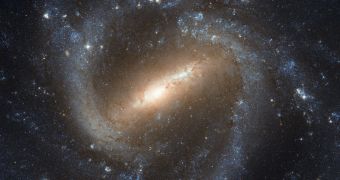Scientists operating the NASA/ESA Hubble Space Telescope unveiled a breathtaking new image yesterday, February 3. The photo depicts NGC 1073, a galaxy that many astronomers refer to as Milky Way's twin. The cosmic structure is only 55 million light-years away, in the constellation Cetus.
According to scientists, this object looks just like our own galaxy, when viewed from the outside. It has a barred spiral configuration, but it also exhibits a few features that the Milky Way does not. By analyzing this structure, scientists hope to be able to figure out more about our own galaxy.
A supermassive black hole is believed to power up NGC 1073 as well. The dark behemoth is being fed by gas density waves that are propelled towards the inner parts of the galaxy by gravity. These waves are also responsible for creating the galaxy's bars.
Each individual bar is made up of extremely-dense lines of regions in which new stars form at a frantic pace. This is why they appear to be so luminous when compared to the rest of the galaxy. The same thing is most likely happening inside the Milky Way as well.
Interestingly, astronomers say, it could be that the central bar(s) only develop(s) in spiral galaxies when the structure ages. Instances in which bars were detected in very young spirals are extremely rare. Additionally, most barred spirals exhibit a high proportion of redder stars.
As each star ages, it tends to shift its color from the intense whitish blue of youth to the red of old age. Astronomers use this to determine how old a galaxy is, on average, or if it's currently producing new stars or not. The bluish color also helps pinpoint stellar nurseries.
Observations have determined that only about 20 percent of spiral galaxies in the early Universe have bars, whereas as many as 67 percent of spirals today feature the structure, Space reports.
Hubble has been conducting studies such as this since 1991. Over the course of its lifetime, the venerable space observatories has been visited for repairs five times, most recently in 2009. The shuttle Atlantis was used for the job, with this being one of its last flights.

 14 DAY TRIAL //
14 DAY TRIAL //